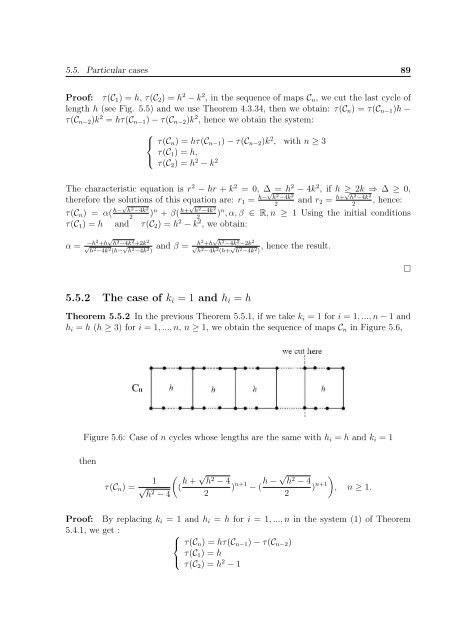enumeration of the number of spanning trees in some ... - Toubkal
enumeration of the number of spanning trees in some ... - Toubkal
enumeration of the number of spanning trees in some ... - Toubkal
You also want an ePaper? Increase the reach of your titles
YUMPU automatically turns print PDFs into web optimized ePapers that Google loves.
5.5. Particular cases 89Pro<strong>of</strong>: τ(C 1 ) = h, τ(C 2 ) = h 2 − k 2 , <strong>in</strong> <strong>the</strong> sequence <strong>of</strong> maps C n , we cut <strong>the</strong> last cycle <strong>of</strong>length h (see Fig. 5.5) and we use Theorem 4.3.34, <strong>the</strong>n we obta<strong>in</strong>: τ(C n ) = τ(C n−1 )h −τ(C n−2 )k 2 = hτ(C n−1 ) − τ(C n−2 )k 2 , hence we obta<strong>in</strong> <strong>the</strong> system:⎧⎨⎩τ(C n ) = hτ(C n−1 ) − τ(C n−2 )k 2 , with n ≥ 3τ(C 1 ) = h,τ(C 2 ) = h 2 − k 2The characteristic equation is r 2 − hr + k 2 = 0, ∆ = h 2 − 4k 2 , if h ≥ 2k ⇒ ∆ ≥ 0,<strong>the</strong>refore <strong>the</strong> solutions <strong>of</strong> this equation are: r 1 = h−√ h 2 −4k 2and r2 2 = h+√ h 2 −4k 2, hence:2τ(C n ) = α( h−√ h 2 −4k 2) n + β( h+√ h 2 −4k 2) n , α, β ∈ R, n ≥ 1 Us<strong>in</strong>g <strong>the</strong> <strong>in</strong>itial conditions2 2τ(C 1 ) = h and τ(C 2 ) = h 2 − k 2 , we obta<strong>in</strong>:α = −h2 +h √ √ h 2 −4k 2 +2k 2h 2 −4k 2 (h− √ and β = h2 +h √ √ h 2 −4k 2 −2k 2h 2 −4k 2 ) h 2 −4k 2 (h+ √ , hence <strong>the</strong> result.h 2 −4k 2 )□5.5.2 The case <strong>of</strong> k i = 1 and h i = hTheorem 5.5.2 In <strong>the</strong> previous Theorem 5.5.1, if we take k i = 1 for i = 1, ..., n − 1 andh i = h (h ≥ 3) for i = 1, ..., n, n ≥ 1, we obta<strong>in</strong> <strong>the</strong> sequence <strong>of</strong> maps C n <strong>in</strong> Figure 5.6,Figure 5.6: Case <strong>of</strong> n cycles whose lengths are <strong>the</strong> same with h i = h and k i = 1<strong>the</strong>nτ(C n ) =(1√h2 − 4( h + √ h 2 − 42) n+1 − ( h − √ h 2 − 4)), n+1 n ≥ 1.2Pro<strong>of</strong>: By replac<strong>in</strong>g k i = 1 and h i = h for i = 1, ..., n <strong>in</strong> <strong>the</strong> system (1) <strong>of</strong> Theorem5.4.1, we get :⎧⎨ τ(C n ) = hτ(C n−1 ) − τ(C n−2 )τ(C 1 ) = h⎩τ(C 2 ) = h 2 − 1

















